Join More Than 50,000+ Subscribers and get latest camera news and rumors
NEW CAMERA VIDEOS ON YOUTUBE
|
By admin, on April 9th, 2014
Sony A7s vs Sony A7 vs SonyA7R, The Sony A7s is a newly announced camera and features step-up core specification compared ti A7 and A7R, First image and size comparison – The Sony A7s look similar in design and size compared to A7..as well as A7R is also exactly same as A7s …
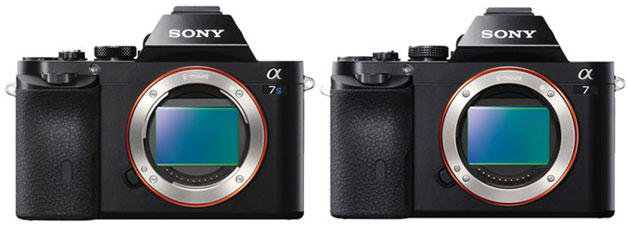
Finally the specification comparison…
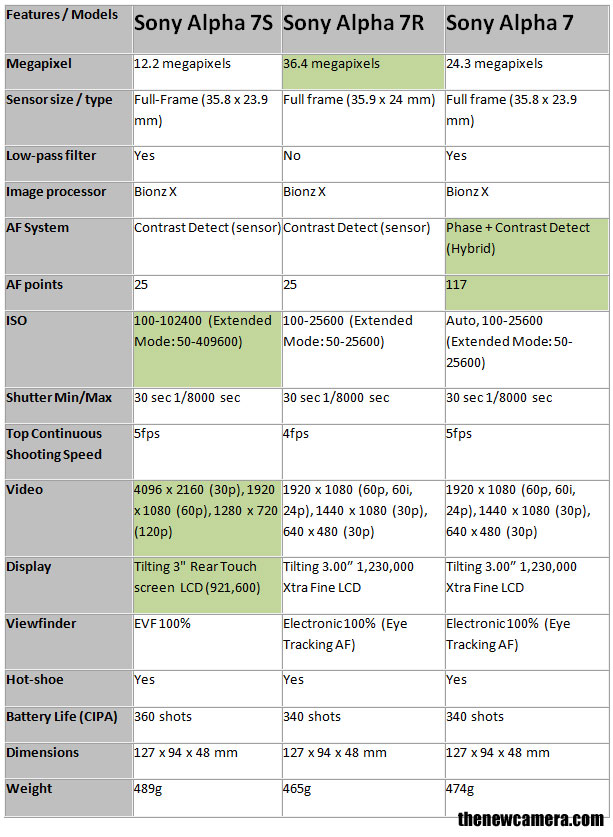
The Sony A7s sensor is optimized to perform very well during low-light situation, take a look at the detailed ISO range of all three sensor,
- Sony A7R – Standard ISO Range 100-25600 (Extended Mode: 50-25600)
- Sony A7 – Standard ISO Range 100-25600 (Extended Mode: 50-25600)
- Sony A7S – Standard ISO Range 100-102400 (Extended Mode: Auto, 50-409600)
Sony A7s has very broad standard + expandable ISO range, A7s highly recommend for still shooters.
No-Optical low pass filter in A7R – Sony A7R doesn’t have low pass filter and features a super 36 Megapixel resolution, So if you work in controlled light environment aka studiography than A7R is perfect for you
Advance AF system in A7: Only A7 features phase + contras based AF system with 117 AF points, Sony A7s and A7R share same contrast based AF system.
4K: The Sony A7s features Full Pixel Read-Out of FF sensor with Clean HDMI Out for 4K Recording , you can record 4k at 30 fps, Full HD @ 60 fps and HD videos @ 120fps..
Verdict: A7s is highly recommended for video lovers as well as still shooters. For sports shooters we recommend you to go with A7, at the end A7R recommended for studiography.
Sony A7 w/ 28-70mm lens – $1,998.00 – Amazon | B&H
Sony A7r @ $2,298.00 from Amazon | B&H
By admin, on April 7th, 2014
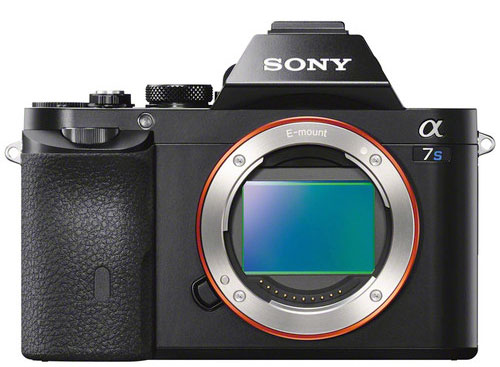
The long rumored Sony A7s finally announced today, the camera features ultra-low light sensitivity sensor with ISO range of 50-409,600, the resolution of Full frame sensor is 12 megapixel.
New sensor technology: The Sony A7s uses completely new sensor technology, the full-frame sensor uses newly developed on-chip gapless lens design, it incorporates small lenses between neighboring pixels in order to increase light-capturing capability and promote greater image quality
The Sony A7s has contrast based AF system with 25 contrast based AF points, it doesn’t have phase AF system aka AF pixels within the sensor.
THE 4K: Sony A7s support 4K video recording via a external recorder, but itself it can record Full HD videos @ 60fps and HD @ 120fps, thanks to the Bionz X processor the A7s does full pixel read-out while recording video, without pixel binning, so you get ultra sharp video footage without any false color artifacts.
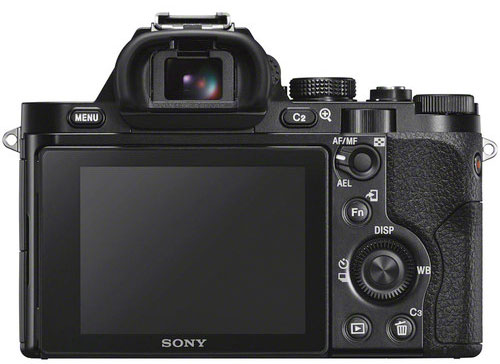
WiFi and NFC: The class leading low-light performance camera supports remote shooting and wireless image transfer, you can control your camera via a smartphone / tablet.
Design: The Sony A7s design is same as Sony A7 and A7R
Sony A7 Price: TBA see
Press Release:
SAN DIEGO, April 6, 2014 – Joining the acclaimed α7 and α7R family of the world’s smallest full-frame interchangeable lens cameras1, Sony’s new α7S model puts extraordinary sensitivity, low noise and spectacular 4K video quality into the hands of professional photographers and videographers.
The innovative α7S camera features a newly developed, 12.2 effective megapixel 35mm Exmor® CMOS sensor paired with a powerful BIONZ X image processor, allowing it to shoot at a sensitivity range of ISO 50 – 4096002 with unprecedented dynamic range and low noise.
The new model is also the world’s first camera to utilize the entire width of a full-frame image sensor in 4K video acquisition, and does this without cropping or line skipping as it can read and process data from every one of the sensor’s pixels. This allows 4K video shooters to utilize all of the artistic and creative benefits provided by the unique sensor.
“The α7S gives Sony the most complete, versatile lineup of full-frame cameras in market today,” said Neal Manowitz, director of the interchangeable lens camera business at Sony Electronics. “Between the α99, VG900, RX1, α7, α7R and now α7S models, we have completely revolutionized what it means to be a ‘full-frame’ camera, bringing a new level of quality and portability to enthusiast photographers and videographers.”
Wide ISO Sensitivity (ISO 50 – 409,6002) and Impressive Dynamic Range
Sony, the world’s largest manufacturer of image sensors, has developed a unique 12.2 MP sensor with extraordinary sensitivity that allows the α7S camera to collect dramatically more light than traditional cameras and to produce beautifully detailed, low-noise images in even the darkest environments.
The camera also features a newly developed on-sensor technology that allows it to optimize the dynamic range throughout the entirety of the ISO50 – 409,600 sensitivity range. This on-sensor technology also broadens the range of tonal gradation in bright environments and minimizes noise in dark scenes, allowing the camera to deliver impressive results in these extreme conditions where other cameras (and image sensors) typically struggle.
World’s First Full-Frame Camera with Full Pixel Read-out3 (without pixel binning) during Movie Shooting
With the new α7S camera, the high-speed read out of the 35mm full-frame image sensor combined with the high-speed processing of the BIONZ X processor enables significant improvements in video quality.
These powerful components allow the camera to process data from all of the sensor’s pixels and output stunning HD and 4K (QFHD 3840 x 2160 pixels) video3 while utilizing the full-width of the sensor. In addition to the benefits for low-light shooting, the read out of all pixels frees the video from aliasing, moiré and false color artifacts (as opposed to pixel binning) to achieve the highest quality video.
Additional Pro-Quality Video Functions
In video mode, the α7S can output 4K video4 at QFHD (3840×2160) to an optional external 3rd party 4K recorder, and can record full HD (1920×1080) at frame rates of 60p, 60i, 30p and 24p directly to a compatible memory card. Video modes can be changed from full-frame to APS-C (super 35mm equivalent) if desired, and in this crop mode, the camera can support high frame rate 120fps shooting at standard HD resolution (1280 x 720p), creating a 5x slow-motion effect.
The α7S camera is also equipped with S-Log2 gamma. Common to Sony’s range of professional video cameras, S-Log2 expands the dynamic range by up to 1300% to minimize clipped highlights and loss of detail in shadows. Additionally, for the first time ever in a Sony α camera, the α7S adopts the workflow-friendly XAVC S recording format in addition to AVCHD and MP4 codecs. XAVC S format allows for full HD recording at a data rate of 50 mbps with lower compression for improved video quality.
Other specialist video functions on the new camera include a picture profile that can adjust settings like gamma, black, level and color adjustment, and can be saved for use in a multi-camera shoot. It also has Full HD and 4K base band HDMI® output, time code/user bit for easier editing, synchronous recording feature with compatible devices, various marker and zebra displays on both the LCD screen and viewfinder and can dual record XAVC S as well as MP4 (1280×720 @30p).
The camera also has a Multi-terminal interface shoe that is compatible with Sony’s XLR Adaptor Microphone Kits (XLR-K1M plus a new model under development), allowing the use of professional microphone systems.
Low-light Shooting Advantages
The high ISO sensitivity range of the α7S camera is extremely effective for still image shooting, especially in low-light conditions, where the camera can shoot at high shutter speeds while keeping noise as low as possible. This is particularly useful for shooting indoor, dimly lit sporting events or other situations where most cameras typically struggle.
The camera is also equipped with the same high-precision Fast Intelligent AF system as the α7R camera, with drastically improved low-light AF sensitivity that can go as low as -4EV.
Expanding α Mount System and New Power Zoom Lens for Movie Shooting
Directly compatible with the growing family of E-mount lenses, the α7S camera can also be used with A-mount and others lens systems with optional adapters. Sony’s complete α lens system now includes 54 total lenses for both A and E mounts, including several premium offerings from Carl Zeiss® and G Series Lenses.
As a whole, Sony’s E-mount lens system is particularly well-suited for video shooting, with a variety of models containing “movie-friendly” features like smooth focusing, powered zoom control, and silent iris/aperture control. Building on this, Sony has announced development of a brand new, full-frame power zoom 28-135mm F4 lens E-mount lens that is an ideal match for the powerful movie capabilities of the α7S model.
Pricing and availability of the α7S full-frame interchangeable lens camera will be announced at a future date. To learn more about the product in the meantime, please visit www.store.sony.com, and follow #SonyAlpha on twitter for the latest α camera news.
Sony A7s Full Specification
- Lens mount: Alpha E-mount
- Image sensor: 12.2MP 35mm full frame (35.6 x 23.8mm), Exmor CMOS sensor
- BIONZ X image processor,
- 14 bit RAW output
- Autofocus: 25 point Contrast-detection AF
- Exposure control metering type 1200-zone evaluative metering
- ISO sensitivity range: ISO 100-102400 (50-409600 expandable)
- Shutter speed: 1/8000 to 30 seconds
- 1.3cm XGA 2,359,296 dots OLED EVF
- 7.5cm 921,600 dots LCD screen
- Recording format: XAVC S / AVCHD format Ver. 2.0 compliant / MP4
- Video compression: XAVC S: MPEG-4 AVC/H.264
- Image size (pixels): XAVC S: 1920 x 1080 (60p/50Mbps, 30p/50Mbps, 24p/50Mbps), 1280 x 720 (120p/50Mbps)
- Clean HDMI output signal: 3840 × 2160(30p/24p) / 1920 × 1080(60p/60i/24p)
- Media formats: Memory Stick PRO-HG Duo, Memory Stick XC-HG Duo, SDXC memory card (UHS-I compliant)
- Connectivity: IEEE 802.11b/g/n Wi-Fi, NFC
- Dimensions: 5 x 3 3/4 x 1 15/16 in.(126.9 x 94.4 x 48.2mm)
- Weight: 446g or 15.7 oz (body only)
Sony A7s Promo Videos
Sony A7s Sample Videos
By admin, on March 29th, 2014
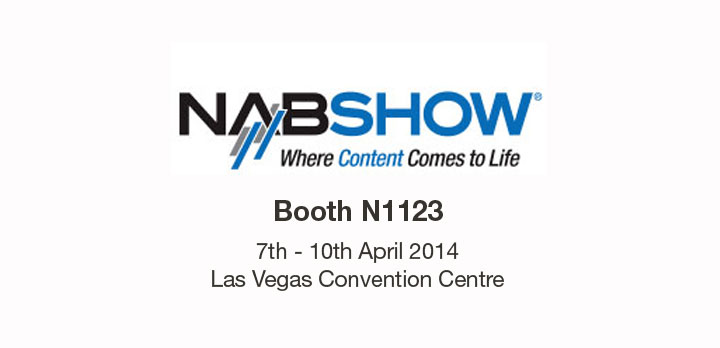
According to latest rumors Canon is rumored to announce two new camera EOS C200 and EOS C400 at NAB 2014, the upcoming camera will be entry level 4K camera and EOS C400 will just sit behind Canon C500 camera.
No more info available about the upcoming DSLRs and compacts, stay with us we will update you soon as we get any new information.
STAY WITH ON FACEBOOK | TWITTER | GOOGLE+ to get live news + rumors 24X7.
By admin, on March 27th, 2014
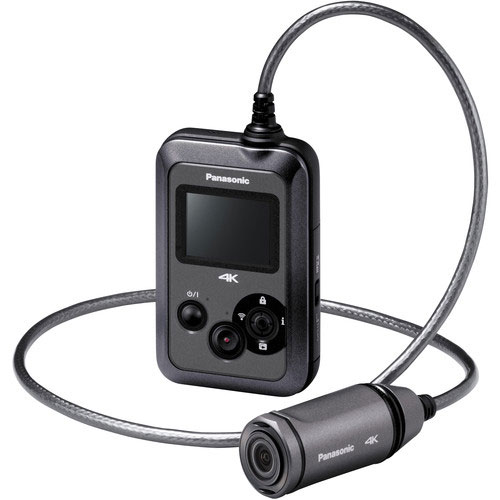
Panasonic announced a wearable 4K camcorder HX-A500, the camcorder is divided into two parts, first part is camera records 4K videos at 30 fps with a 1/2.3″ BSI sensor, Full HD recording is also available at 60 /30 fps and high-speed recording can be done upto 240 fps at lower resolution.
The other part connected via wire is a recorder, the recorder have very few buttons for fast and easy operation and comes with built in WiFi and NFC.
The system is waterproof up to 10 feet so you can also record pain free 4K video during your diving adventures.
HX A500 available for pre-order at B&H Store
HX A500 Sample Video
By admin, on March 27th, 2014
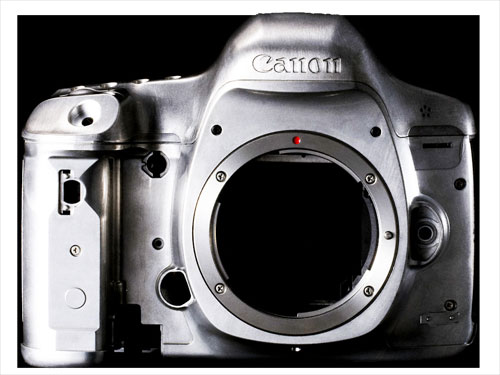
According to latest rumors Canon may announce a camera above 5D series line-up that will feature a high resolution sensor and will record 4K videos, the price is between Canon 1DX and Canon 5D Mark III DSLR.
Multiple report over different websites almost confirmed us that Canon is testing high Megapixel FF sensors at different parts of the globe, Canon EOS A1 / 3D (name is not confirmed yet) will not replace any current DSLR but it will create a new camera line-up as started by Nikon D800 / D800E.
PS: Nikon is also planning to announce Nikon D800/E successor Nikon D800s.
Take a look at the post published on Dec, 2014 – Canon EOS A1 – Megapixel Monster Camera from Canon
STAY WITH ON FACEBOOK | TWITTER | GOOGLE+ to get live news + rumors 24X7.
src-Northlight
By admin, on February 15th, 2014
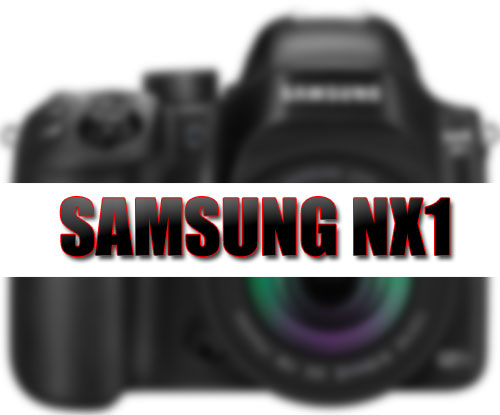
The Samsung NX1 specification surfaced over the web today, the NX1 is rumored to feature 28 Megapixel APS-C sensor with Hybrid AF, the camera will also record 4K videos, take look specification below
Samsung NX1 Rumored Specification
28 MP APS-C CMOS Sensor
Hybrid AF sesnor
UHD 4K 3840×2160 at 30p/24p
Full HD up to 60p
Magnesium Alloy, Weather-Sealed Body
The camera is rumored to be announced on April 2014, Stay with us on Facebook and Google plus, more update coming soon. | See more Samsung Rumors
By admin, on February 7th, 2014
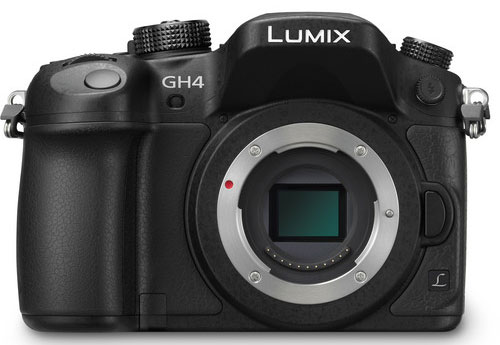 The long rumored panasonic GH4 announced today the camera features 4K recording option, thanks to the newly optimized 16 Megapixel sensor and advance Venus Engine IX processor, the camera can record 4K OR Quad HD (3840 x 2160) at up to 29.97p and ‘Cinema 4K’ (4096 x 2160) at up to 24p. The long rumored panasonic GH4 announced today the camera features 4K recording option, thanks to the newly optimized 16 Megapixel sensor and advance Venus Engine IX processor, the camera can record 4K OR Quad HD (3840 x 2160) at up to 29.97p and ‘Cinema 4K’ (4096 x 2160) at up to 24p.
The camera also features newly decloped high-precision Contrast AF system – DFD (Depth from Defocus) technology with High-Speed 49-Point Autofocus, that takes approx 0.04 sec to lock down AF under normal condition.
Other fetures include built in WiFi and NFC, RAW data development in Camera: The DMC-GH4 is capable of developing RAW image in camera.
Pre-Order at Amazon
Pre-order Panasonic GH4 from B&H
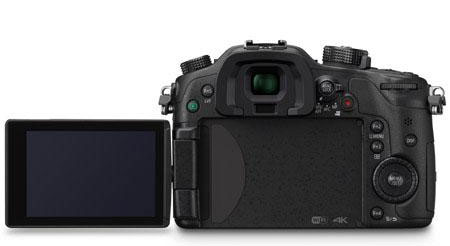
A Digital Single Lens Mirrorless (DSLM) Camera DMC-GH4 with New AF Technology and the World’s First* 4K Video Recording Capability (for a mirrorless camera) To Meet Professional Needs for Both Photography and Videography
Panasonic is proud to introduce an ultimate photo/video hybrid Digital Single Lens Mirrorless (DSLM) camera DMC-GH4 for the successor of DMC-GH3 that created an industrial sensation with its outstanding video recording performance. The image quality for both photo and video is dramatically improved by crystallizing Panasonic’s cutting-edge technologies.
The newly developed 16.05-megapixel Digital Live MOS Sensor for DMC-GH4 excels both in sensitivity and response and suppresses rolling shutter effect even when using electronic shutter or recording motion image. The image processor Venus Engine is also newly developed dramatically boosting its performance with new quad-core CPU that lets high speed signal processing required for rich video recording such as 4K. Integrating superior noise reduction systems, DMC-GH4 enables shooting at max.ISO25600. Sensitivity, gradation performance, resolution and color reproduction are dramatically improved to achieve even higher picture quality. The DMC-GH4 boasts high speed burst shooting at 12 fps(AFS) up to approx.40 (including RAW) / approx.100 (excluding RAW) and 7.0 fps (AFC) to capture fast moving subject just in-focus.
The new DMC-GH4 further evolves to bridge the gap of consumer video camera and professional video camera. One of the most prominent advance is unlimited*14K video recording (Cinema 4K: 4096×2160 / 24 fps and QFHD 4K: 3840×2160 / up to 30 fps) in MOV/MP4*2. The DMC-GH4 is also
capable of recording Full- HD video with ultra high bitrate at 200 Mbps (ALL-Intra) or 100 Mbps (IPB) without recording time limit*1.
Users can freely choose the format from MOV, MP4, AVCHD Progressive and AVCHD at a variety of frame rates according to the usage. For the global business of professional users, the system frequency can be flexibly selectable between 59.94Hz (23.98Hz) / 50.00Hz / 24.00Hz. The DMC-GH4 is also capable of real-time image output to the external monitor via an optional micro HDMI cable simultaneously while recording video. For more unique video expression, VFR (Variable Frame Rate) or Time Lapse/Stop Motion Animation can be produced with DMC-GH4 without postproduction process. In addition, a variety of practical functions required for professional video recording are newly integrated.
The high-precision Contrast AF system in the DMC-GH4 is further enhanced by Panasonic’s integration of DFD (Depth from Defocus) technology which even shortens the time to set focus to achieve ultra high speed AF of approx.0.07 sec*3. Not only speed but also the operability is enhanced
thanks to the addition of Face / Eye Detection AF or 49-point AF with Custom Multi AF mode.
The DMC-GH4 boasts newly developed high-precision, high-speed dual OLED (Organic Light-Emitting Diode) displays for 2,359K-dot LVF (Live View Finder) and 1,036K-dot rear monitor. Both LVF and rear monitor adopts OLED to achieve high speed response with minimum time lag while enhancing the resolution. Notably, the OLED for the LVF in DMC-GH4 boasts 10,000:1 high contrast for superior color reproduction. Now the excellent visibility comes closer to OVF.
To be tough enough to withstand even heavy field use, the main structure of the DMC-GH4 is composed of magnesium alloy full diecast front/rear frame. It also features splash / dustproof construction thanks to the sealing on every joint, dial, and button. The shutter unit that allows max. 1/8000 fast shutter release is also redesigned to be even more durable for approx. 200,000 times release*4.
Even a moment’s waste matters in professional shooting condition, hence it is possible to make target setting intuitively thanks to the optimum layout of control devices on DMC-GH4 . The DMC-GH4 also incorporates Wi-Fi® with NFC technology, terminals highly connectable to external equipment. Now RAW files can be developed in camera.
Evolving further in every aspect – performance, mobility, durability and expandability, Panasonic is proud to offer DMC-GH4 for a reliable first camera to professional field photographers, film creators and hybrid photographers.
*1 — Motion image can be recorded up to 29 min 59 sec depending on the recording format and the camera’s sales area.
*2 — Use SDXC/SDHC Memory Card compatible with UHS Speed Class 3 (U3) when using high bitrate video recording mode over 100 Mbps.
*3 — In AFS, With LUMIX G VARIO 14-140mm / F3.5-5.6 ASPH. / POWER O.I.S. or LUMIX G X VARIO 12-35mm / F2.8 ASPH. / POWER O.I.S.
*4 — Panasonic in-house examination.
1. The Newly Developed 16.05-Megapixel Digital Live MOS Sensor and Venus Engine Achieving High Speed, High Sensitivity Image Recording
Panasonic developed new 16.05-megapixel Digital Live MOS Sensor for DMC-GH4 that achieves high quality, high sensitivity image recording with quick response. Approx. 50% higher speed signal readout suppresses rolling shutter effect even when using electronic shutter or recording motion image. The maximum number of recordable images is up to 40(including RAW) / 100 (excluding RAW). Taking full advantage of the Live MOS Sensor, gradation range is expanded by max.1/3 step at low ISO end with fine tuning control by the Venus Engine. Plus, superior noise reduction realizes max.60 min long exposure in B(bulb) mode.
The image processor Venus Engine is also newly developed dramatically boosting its performance with new quad-core CPU that lets high speed signal processing required for rich video recording such as 4K. The advanced Multi-process NR (Noise Reduction) applies effective noise reduction and edge processing according to each component frequency. Plus, newly added Random Filter granulates chromatic noise to be blended into the image even more naturally. As a result, the max. ISO 25600 is achieved. On the other hand, optimizing the combination design of new sensor, new imaging engine and low-pass filter enhances the limit resolution by more than 5% while suppressing moire. Newly adopted aperture filter is capable of controlling over wider frequency range. It adjusts the amount of sharpness according to the frequency level, resulting in faithful stereoscopic effect. The Venus Engine also
improves color reproduction with accurate evaluation of each color even it is similar not only in color phase but also in saturation and luminosity.
The combination of the Digital Live MOS Sensor and the Venus Engine achieves stunning picture quality in its natural way – that is what LUMIX aspires for.
2. The World’s First Digital Single Lens Mirrorless (DSLM) Camera Recording High Quality Video in 4K – To Meet Professional Quality and Standard
The predecessor DMC-GH3 created an industrial sensation with its outstanding video recording performance that meets the professionals’ quality and standard. The new DMC-GH4 further evolves to bridge the gap of consumer video camera and professional video camera. One of the most prominent advance is unlimited*1 4K video recording (Cinema 4K: 4096×2160 / 24 fps and QFHD 4K: 3840×2160 / up to 30 fps) in MOV/MP4*2. The DMC-GH4 is also capable of Full- HD video with ultra high bitrate at 200 Mbps (ALL-Intra) or 100 Mbps (IPB), which does not have limit of recording time*1. Users can freely choose the format from MOV, MP4, AVCHD Progressive and AVCHD at a variety of frame rates according to the usage [Figure#1]. In MP4 / MOV, high quality sound in LPCM (Linear Pulse Code Modulation) is recordable. For the global business of professional users, the system frequency can be flexibly selectable between 59.94Hz (23.98Hz) / 50.00Hz / 24.00Hz.
The DMC-GH4 is also capable of real-time image output to the external monitor in 4:2:2 / 8-bit*3 via an optional micro HDMI cable simultaneously while recording video. Even 4:2:2 / 10-bit is available which is suitable for the professional video making that requires serious monitoring of the footage. Users can choose to output only the recording content or the content with the setting menus individually depending
on a display.
Plus, the VFR (Variable Frame Rate) enables recording video with slow/fast motion such as 96 fps, 4x, all in Full-HD[Figure#2]*4. Time Lapse/ Stop Motion Animation video can be produced in camera, too.
For more precise control over video image quality, the DMC-GH4 integrates Zebra Pattern to watch white wash-out or Focus Peaking. The DMC-GH4 even allows Master Pedestal system is newly integrated with which users can adjust the brightness balance ±15 steps based on the color of black. Gamma presets exclusively for video recording are newly available in Creative Video mode – “CINELIKE D” and “CINELIKE V” for rich video expression like a cinema. Synchro Scan mode is also newly availableto reduce suppress flicker. It is selectable to display Center Marker while recording.
The DMC-GH4 is equipped with functions that meets global standard for synchronous video recording. 1KHz Test Tone and Color Bars(SMPTE / EBU / ARIB Standard) are newly available on DMC-GH4. The DMC-GH4 also embeds SMPTE-compliant Time Code either in Rec Run or Free Run count-up methods, which makes it easy to synchronize the multiple video footage or sound source in the post production workflow. Time Code Value can be started at any point of [Reset], [Manual Input] and [Current Time]. Drop frame or Non Drop Frame time code is selectable*5. When recording the video in MOV, AVCHD Progressive, AVCHD or MP4(LPCM), the DMC-GH4 automatically generates multiple seamless files for continuous recording. During playback, the AVCHD Progressive / AVCHD files are reproduced with seamless, interruption-free continuity.
A total of 22 LUMIX G digital interchangeable lenses offers any creative perspective according to the scene. Especially those crowned as HD lenses allows silent, high performance AF control suitable for video recording.
* 1 — Motion image can be recorded up to 29 min 59 sec depending on the recording format and the camera’s sales area.
*2 — Use SDXC/SDHC Memory Card compatible with UHS Speed Class 3 (U3) when using high bitrate video recording mode over 100
Mbps.
*3 — Setting the HDMI output picture quality [4:2:2 10bit]:You can output the image through the HDMI connection in higher picture quality, but you cannot record it as a motion picture or still pictures. Ideal when the HDMI output is to be saved on external devices. [4:2:2 8bit]:You can record the image while outputting it through the HDMI connection. Ideal for recording while checking the motion picture on an external monitor. When using 4:2:2 / 8-bit output, video is recorded in 4:2:0 / 8-bit on SDXC/SDHC Memory Card.
*4 — In 24p playback. Effect value varies depending on the recording format and frequency.
*5 — When system frequency [59.94Hz] is selected
3. High Speed Response Required for Professionals and Practical AF Options
All cameras of LUMIX G adopt Contrast AF for its focus system. Compared with the Phase difference system AF, the Contrast AF boasts higher accuracy especially in shooting with bright lens with small F value. With the LUMIX G digital interchangeable lens capable of digital signal exchange at max. 240 fps, the focusing is stunningly quick and smooth. The Contrast AF system in the DMC-GH4 is furtherenhanced by Panasonic’s integration of DFD (Depth from Defocus) technology which even shortens the time to set focus. It figures out the distance to the subject by evaluating 2 images with different depth of field while consulting the data of optical characteristics of the using lens in a moment. As a result, the DMC-GH4 achieves ultra high speed AF of approx.0.07 sec*. This improvement benefits more as focusing distance increases. The speed of burst shooting is dramatically faster than the predecessor DMC-GH3, boasting high speed burst shooting at 12 fps (AFS) up to approx.40 (including RAW) / approx.100 (excluding RAW) and 7.0 fps (AFC) to capture fast moving subject just in-focus.
Not only these, stability of continuous focusing is improved focusing is now even smoother by minimizing wobbling in both photo and video recording. Together with the quick start-up and short release time lag, the DMC-GH4 never lets photographers miss fleeting shooting opportunities.
In addition to the conventional Face Recognition AF, the DMC-GH4 newly incorporates Eye Detection AF which automatically sets focus right on the eye of human face. Focus point is increased from 23 (DMC-GH3) to 49 points for more flexible composition together with Custom Multi AF mode in which users can freely select the blocks to focus out of the 49 focusing area. Now the 1-area AF area can be seamlessly magnified not only in manual but also in auto focus mode. Tracking AF is also advanced in the point of tracking accuracy by estimating the subject’s movement.
Focus point can be set on any part of the 100% field of view. The time to show magnified image can be selectable in Pin-point AF. Focus point can be magnified either with MF ring or with cursor key in MF Assist mode. In the Touch Pad AF, the position can be set either on absolute/relative coordinate. Together with the Eye Sensor AF which starts focusing by just looking into the viewfinder, the AF/AE lock button works for AF for quick auto focusing even when using LVF.*
In AFS, With LUMIX G VARIO 14-140mm / F3.5-5.6 ASPH. / POWER O.I.S. or LUMIX G X VARIO 12-35mm / F2.8 ASPH. / POWER O.I.S.
4. Stunning Mobility Supported by Mechanical Advancements
The DMC-GH4 boasts newly developed high-precision, high-speed dual OLED (Organic Light-Emitting Diode) displays for LVF (Live View Finder) and rear monitor. Increasing the resolution of display area to 2,359K-dot, the new 16:9 Wide Screen LVF boasts approx.1.34x / 0.67x (35mm camera equiv.) magnification and 100% field of view and eyepoint of approximately 21 mm. Thanks to the newly designed large eyecup, the visibility of LVF is dramatically improved. The image output between the LVF and the rear monitor is switched automatically with the eye sensor on the LVF, which features options of sensitivity – high, low and off – to reduce false operation during touching on the rear monitor. The 3.0-inch 1,036K-dot free-angle OLED rear monitor (3:2 aspect) with wide-viewing angle rotates 180° to the side and tilts 270° up and down offers approx. 100% of field of view. This rear monitor adopts static touch control for more smooth operation either in shooting or in playback. Both LVF and rear monitor adopts OLED to achieve high speed response with minimum time lag while enhancing the resolution. Notably, the OLED for the LVF in DMC-GH4 boasts 10,000:1 high contrast for superior color reproduction. Now the excellent visibility comes closer to OVF. On the other hand, live view image can be displayed in monochrome through LVF which enables shooting concentrating on contrast.
Even a moment’s waste matters in professional shooting condition but it is possible to make target setting intuitively with DMC-GH4. The 3 dials are equipped on the top and back of the camera and the main dial is now comes with lock structure. A dedicated button allows direct reach to exposure compensation, white balance adjustment or ISO setting and max.5 settings can be assigned to the Fn button. All these external components are designed to be operated easily without taking eyes off through the viewfinder.
To be tough enough to withstand even heavy field use, the main structure of the DMC-GH4 is composed of magnesium alloy full diecast front/rear frame. It also features splash / dustproof construction thanks to the sealing onto every joint, dial, and button. The shutter unit is also redesigned to be even more durable for approx. 200,000 times release*. It offers highest shutter speed at max. 1/8000 not only to capture spur-of-the-moment of fast moving subject but also to use high-speed lens with open aperture even in outdoors to give impressive defocus. Both built-in/external flash can be synchronized with max.1/250 second shutter speed*.
Panasonic in-house examination.
5. Expandability for A Variety of Workflows
Easy Wireless Connectivity via Wi-Fi® / NFC with Smartphones
The DMC-GH4 integrates Wi-Fi® connectivity (IEEE 802.11 b/g/n) with NFC (Near Field Communication) technology camera to offer more flexible shooting experience and instant image sharing with easy operation. With Panasonic “Image App”, remote shooting of both photo and video* is available by using the smartphone/tablet for a remote shutter with a monitor. Not only releasing a shutter, zooming, focusing and settings of shutter speed, aperture, exposure compensation are all controllable with a smartphone / tablet. All these flexible shooting / browsing / sharing style are made possible with the DMC-GH4 and the Panasonic’s dedicated application software Panasonic Image App for iOS / Android smartphones / tablets. It is also easy to embed geotag in the image after shooting. For the smartphone/tablet without NFC, the camera displays dedicated QR code on its monitor to complete pairing easily by reading the code.
Output/Input Terminals
The DMC-GH4 comes with a variety of connection terminals for more flexible shooting options. The 3.5mm microphone jack is for high quality audio recording using an external microphone and the 3.5mm headphone jack which enables monitoring the recording audio while shooting video real-time. It is also capable of real-time image output on the external monitor via an optional HDMI micro cable simultaneously while recording video. In addition to these, the DMC-GH4 complies with AV outputs (Audio 2ch, Composite), flash sync terminal and 2.5mm jack for remote controller.
For reliable recording of rich video, the DMC-GH4 complies with UHS Speed Class 3 (U3) which is the new speed class standard of SD memory card. The UHS Speed Class 3 (U3) guarantees a constant minimum write speed of 30MB/s to respond to market needs for 4K video.
Optional Accessories
A GN58 powerful External Flash (DMW-FL580L) is newly added to the LUMIX G optional accessories which allows high speed charging of approx.1.7 sec. Not only wireless control but also LED video light function are available. The Stereo / Shotgun Microphone (DMW-MS2) which enables stereo/shotgun
switch even allows more precise sound recording with selectable Super Shotgun / Lens Auto / Manual option on DMC-GH4.
6. Other Features
Luminance Level Adjustment
Just as the concept of “ultimate hybrid Digital Single Lens Mirrorless camera” identifies, the DMC-GH4 supports smooth postproduction for photographers newly challenging videography. In addition to the standard luminance level of 16-235 and 16-255, DMC-GH4 offers 0-255 which is equivalent to photo standard (16-235, 16-255 and 0-255 are all 8-bit).
Focus Peaking
For more practical control over focusing, the DMC-GH4 incorporates Focus Peaking function that shows the peak of focus in MF and AF+MF mode. Users can see the peaking of focus while monitoring the subject in live view. It can be set to HIGH / LOW / OFF and the color can also be changed to blue, white or orange according to the color of the shooting scene during live view. Users can take advantage of this function when controlling the camera with smartphone / tablet via Wi-Fi in both photo / video recording.
Silent Mode
This mode switches shutter from mechanical to electronic and turns all sound (AF, operation) off while suppress emission of AF assist lamp and flash with just a single setting for special shooting occasions.
Highlight/Shadow Control
The Live View function is also advanced digitally making it possible to adjust highlight / shadow separately with the front/rear dial. 3 patterns of settings can be customized in addition to 3 patterns of preset.
RAW data development in Camera
The DMC-GH4 is capable of developing RAW image in camera. In addition to the color space setting ( sRGB / AdobeRGB ), the parameter of white balance, exposure compensation, contrast, highlight/shadow, saturation, noise reduction, sharpness or hue can be flexibly adjusted while LUMIX’s
Photo Style, Intelligent D-range Control, Intelligent Resolution can also be applied.
Interface Unit (DMW-YAGH)
Panasonic newly offers an Interface Unit (DMW-YAGH) exclusively for professional/industrial workflow with the DMC-GH4 that enables more powerful video transmission. It complies with Full HD (4:2:2 / 10-bit) four parallel outputs and these can be used for 4K (4:2:2 / 10-bit) output – both with time code*1. The XLR input terminals (2ch) are also equipped to connect line or condenser microphone. When connecting with microphone, volume can be controlled for L and R separately, which can be monitored LED audio level display on the back of the unit. The 12V DC IN is highly compliant with large-capacity industrial battery and continuously supplies the DMC-GH4 with power*2.
*1 — Setting the HDMI output picture quality [4:2:2 / 10bit]: You can output the image through the HDMI connection in higher picture quality, but you cannot record it as a motion picture or still pictures. Ideal when the HDMI output is to be saved on external devices. When using 4:2:2/10-bit output, simultaneous video recording onSDXC/SDHC Memory Card in the camera is not possible.
* 2 — HDMI output from the camera is not possible when the camera is mounted on the Interface Unit.
•The “AVCHD” is a high definition (HD) digital video recording / playback format jointly established by Panasonic Corporation and Sony
Corporation.
• “AVCHD Progressive”, “AVCHD”, the “AVCHD Progressive” Logo and the “AVCHD” Logo are trademarks of Panasonic Corporation and
Sony Corporation.
•Android and Google Play are trademarks or registered trademarks of Google Inc.
• IOS is a trademark or registered trademark of Cisco in the U.S. and other countries and is used under license.
• HDMI, the HDMI Logo, and High-Definition Multimedia Interface are trademarks or registered trademarks of HDMI Licensing LLC in the
United States and other countries.
•All other company and product names are trademarks of their respective corporations.
•This unit is compatible with both SD/SDHC/SDXC Memory Cards. You can only use SDHC/SDXC Memory Cards on devices that are
compatible with them. You cannot use SDHC/SDXC Memory Cards on devices that are only compatible with SD Memory Cards. (When
using an SDHC/SDXC Memory Card on another device, be sure to read the operating instructions for that device.)
•SDHC Memory Cards and SDXC Memory Cards can be used only in equipment that is compatible with their respective formats.
• If the computer being used does not support SDXC Memory Cards, a message prompting you to format may appear. (Doing so will
cause recorded images to be erased so do not choose to format.) If the card is not recognized, please refer to the below support site.
http://panasonic.net/avc/sdcard/information/SDXC.html[Open New Window]
•Some accessories are not available in some countries.
•The use of recorded or printed materials that are protected by copyright for any purpose other than personal enjoyment is prohibited, as
it would infringe upon the rights of the copyright holder.
•Design and specifications are subject to change without notice.
Panasonic DMC-GH4 Specifications
| Camera Type |
Digital Single Lens Mirrorless camera |
| Recording Media |
SD Memory Card, SDHC Memory Card, SDXC Memory Card (Compatible with UHS-I standard SDHC / SDXC Memory Cards) |
| Image Sensor Size |
17.3 x 13.0 mm (in 4:3 aspect ratio) |
| Lens Mount |
Micro Four Thirds mount |
| Image Sensor |
Type: Live MOS Sensor
Total Pixels: 17.20 Megapixels
Camera Effective Pixels: 16.05 Megapixels
Color Filter: Primary color filter
Dust Reduction System: Supersonic wave filter |
| Recording File Format |
Still Image: JPEG (DCF, Exif 2.3), RAW MPO (When attaching 3D lens in Micro Four Thirds System standard)
Motion Image: AVCHD Ver 2.0 compliant (AVCHD Progressive), MPEG4-AVC (H.264). (MOV, MP4) |
| Aspect Ratio |
4:3, 3:2, 16:9, 1:1 |
| Image Quality |
RAW, RAW+Fine, RAW+Standard, Fine, Standard MPO+Fine, MPO+Standard (When attaching 3D lens in Micro Four Thirds System standard) |
| Color Space |
sRGB, Adobe RGB |
| Still Image Resolution |
[4:3] 4,608 x 3,456 (L), 3,264 x 2,448 (M), 2,336 x 1,752 (S), 1,824 x 1,368 (When attaching 3D lens in Micro Four Thirds System standard)[3:2] 4,608 x 3,072 (L), 3,264 x 2,176 (M), 2,336 x 1,560 (S), 1,824 x 1,216 (When attaching 3D lens in Micro Four Thirds System standard)[16:9] 4,608 x 2,592 (L), 3,264 x 1,840 (M), 1,920 x 1,080 (S), 1,824 x 1,024 (When attaching 3D lens in Micro Four Thirds System standard) |
| Still Image Resolution cont. |
[1:1] 3,456 x 3,456 (L), 2,448 x 2,448 (M), 1,744 x 1,744 (S), 1,712 x 1,712 (When attaching 3D lens in Micro Four Thirds System standard) |
| Motion Image |
MOV: [4K] 3840×2160 – [Full HD] 1920×1080 – [C4K] 4096×2160
MP4: [4K] 3840×2160 – [Full HD] 1920×1080 – [HD] 1280×720 – [VGA] 640×480 – [C4K] 4096×2160 |
| Continuous Record Time (Motion Image) |
AVCHD: Approx. 220 min with H-HS12035
AVCHD: Approx. 220 min with H-FS14140 |
| Actual Record Time (Motion Image) |
TBD |
| Wi-Fi |
IEEE 802.11b/g/n, 2412 MHz – 2462 MHz (11 ch), Wi-Fi / WPA / WPA2, Infrastructure mode, WPS, Wi-Fi Direct |
| NFC |
ISO/IEC 18092, NFC-F (Passive Mode) |
| QR Code Connection |
Yes |
| Viewfinder |
Type: OLED Live View Finder (2,359K dots equivalent)
Field of View: Approx. 100%
Magnification: Approx. 1.34x / 0.67x (35 mm camera equivalent)
Eye Point: Approx. 21 mm from eyepiece lens
Diopter Adjustment: -4.0 – +4.0 (dpt)
Auto Eye Sensor: Yes |
| Focus |
Type: Contrast AF system
Focus Mode: AFS (Single) / AFF (Flexible) / AFC (Continuous) / MF
AF Mode: Face detection / AF Tracking / 49-area-focusing / 1-area-focusing / Pinpoint (Full area touch is available)
AF Assist Lamp: Yes
AF Lock: Yes (AF/AE LOCK button)
One Shot AF, Shutter AF, Half Press Release, Quick AF, Continuous AF (during motion picture recording), Eye Sensor AF, AF+MF, MF Assist, Touch MF Assist, Focus Peaking, Touch AF/AE |
| Light Metering System |
1,728-zone multi-pattern sensing system (TBD) |
| Light Metering Mode |
Multiple / Center Weighted / Spot |
| Metering Range |
EV 0 – 18 (F2.0 lens, ISO100 equivalent) |
| Exposure Mode |
Program AE / Aperture Priority AE / Shutter Priority AE / Manual |
| ISO Sensitivity |
Auto / Intelligent ISO / 100 (Extended) / 200 / 400 / 800 / 1600 / 3200 / 6400 / 12800 / 25600 (Changeable to 1/3 EV step) (Up to ISO6400 in motion picture recording) (ISO Auto in M mode) |
| Exposure Compensation |
1/3 EV Step, ±5 EV (±3 EV for motion image) |
| AE Lock |
AF/AE LOCK button |
| AE Bracket |
3, 5, 7 frames, in 1/3, 2/3 or 1 EV Step, single / burst |
| White Balance |
Auto / Daylight / Cloudy / Shade / incandescent / Flash / White Set 1, 2, 3, 4 / Color temperature setting |
| White Balance Adjustment |
Blue/Amber bias, Magenta/Green bias |
| Color Temperature Setting |
2500-10000K in 100K |
| White Balance Bracket |
3 exposures in blue/amber axis or in magenta/green axis |
| Shutter Type |
Focal-plane shutter |
| Shutter Speed |
Still image: Bulb (Max. 60 minutes), 1/8,000 – 60
Motion picture: 59.94Hz: 1/16,000 – 1/30, 50.00Hz: 1/16,000 – 1/25, 24.00Hz: 1/16,000 – 1/24 (24.00Hz: 1/16,000 – 1/24 (When using Synchro Scan) |
| Shutter Life |
Approx. 200,000 images |
| Self Timer |
10sec, 3 images / 2sec / 10sec |
| Remote Control |
Remote control with Bulb function by DMW-RSL1 (Optional) |
| Burst Speed |
Mechanical shutter: H: 12.0 frames/sec (with AFS), 7.5 frames/sec (with AFC) (TBD), M: 7.5 frames/sec (with Live View), L: 2.0 frames/sec (with Live View)
Electronic shutter: SH: 40.0 frames/sec, H: 20.0 frames/sec, M: 7.5 frames/sec (with Live View), L: 2.0 frames/sec (with Live View)” |
| Number of Recordable Images |
Approx. 40 images (when there are RAW files with the particular speed)
Approx. 100 images (when there are no RAW files)
Approx. 120 images (when using electronic shutter) (depending on memory card size, battery power, picture size, and compression)” |
| Flash |
Built-in Flash: TTL Built-in-Flash, GN12.0 equivalent (ISO100 · m), GN17.0 (ISO200 · m), Built-in Pop-up (Reference)
Flash Mode: Auto, Auto / Red-eye Reduction (when iA, iA+), Forced ON, Forced ON / Red-eye Reduction, Slow Sync., Slow Sync. / Red-eye Reduction
Sync Speed: Less than 1/160 second
Flash Output Adjust: 1/3 EV Step ±3 EV
Flash Sync: 1st Curtain Sync., 2nd Curtain Sync
Sync for Flash Dimming and Exposure Compensation: Yes (ON / OFF)
Flash Sync Socket: Yes |
| Monitor |
Type: OLED monitor with static touch control
Monitor Size: Free-angle 3.0 inch (7.5 cm) / 3:2 Aspect / Wide-viewing angle
Pixels: 1036K dots
Field of View: Approx. 100%
Monitor Adjustment
Brightness (7 levels), Color (7 levels), Red-Green (11 levels), Blue-Yellow (11 levels) |
| Live View |
Digital Zoom: 2x, 4x
Extra Tele Conversion: Still image: Max. 2x (Aspect ratio sets at 4:3. Not effective with L size recording. Magnification ratio depends on the recording pixels and aspect ratio.) Motion picture: 2.4x (FHD), 3.6x (HD), 4.8x (VGA)
Other functions: Level Gauge, Real-time Histogram, Guide Lines (3 patterns), Center Marker, Highlight display (Still image / motion picture), Zebra pattern (Still image / motion picture) |
| Photo Style |
Still Image and Motion Image: Standard / Vivid / Natural / Monochrome / Scenery / Portrait / Custom |
| Creative Control Still Image |
Expressive / Retro / High Key / Low Key / Sepia / Dynamic Monochrome / Impressive Art / High Dynamic / Cross Process / Toy Effect / Miniature Effect / Soft Focus / Star Filter / One Point Color |
| Creative Control Motion Image |
Expressive / Retro / High Key / Low Key / Sepia / Dynamic Monochrome / Impressive Art / High Dynamic / Cross Process / Toy Effect / Miniature Effect / One Point Color |
| Creative Video Mode Exposure Mode |
Program AE / Aperture-Priority / Sutter-Priority / Manual Exposure |
| Motion Picture Function |
Master pedestal level: 31 steps
luminance level: 0-255 / 16-235 / 16-255
Synchro scan: Yes
Time code: Count Up: Rec Run/Free Run selectable, Time Code Mode: Drop frame/Non-drop frame selectable (When system frequency [59.94Hz] is selected.)
SS/Gain operation: Shutter Duration/ISO / Angle/ISO / Shutter Duration/dB
Color bars / 1K Hz test tone: Yes (SMPTE / EBU / ARIB) / Yes
Cinelike gamma: Cinelike D / Cinelike V |
| Playback Mode |
Normal playback, 30-thumbnail display, 12-thumbnail display, Calendar display, Zoomed playback (Max. 16x), Slideshow (All / Picture Only / Video Only / 3D / Category Selection / Favorite, duration & effect is selectable), Playback Mode (Normal / Picture / Video / 3D Play / Category / Favorite), Location Logging, RAW Processing, Clear Retouch, Title Edit, Text Stamp, Video Divide, Time Lapse Video, Stop Motion Video, Resize, Cropping, Rotate, Rotation Display, Favorite, DPOF Print Set |
| Image Protection / Erase |
Protection: Single / Multi, Cancel
Erase: Single / Multi / All / Except Favorite |
| Print |
Direct Print: PictBridge compatible |
| USB |
USB 2.0 High Speed |
| HDMI Monitor-through |
4:2:2 8-bit / 4:2:2 10-bit (When 4:2:2 10-bit mode is selected, it is not possible to record motion picture or still picture on the SD memory card in the camera unit.)
information display ON/OFF (selectable)
Automatic down-conversion (4K } 1080p only) |
| HDMI Playback |
miniHDMI TypeD / VIERA Link, Audio: Stereo
59.94Hz: Auto / 4K / 1080p / 1080i / 720p / 480p
50.00Hz: Auto / 4K / 1080p / 1080i / 720p / 576p
24.00Hz: Auto / C4K / 4K / 1080p
(4:2:2 10-bit or 4:2:2 8-bit is selectable.) |
| Audio Video Output |
Monaural Type |
| Remote Input |
2.5mm for remote |
| External Microphone Input |
3.5mm for external microphone |
| Headphone Output |
3.5mm for headphone |
| Microphone |
Stereo, Wind-cut: OFF / Low / Standard / High / Auto |
| Speaker |
Monaural |
| OSD Language |
English, German, French, Italian, Spanish, Polish, Czech, Hungarian, Russian, Chinese (Traditional), Chinese (Simplified), Dutch, Thai, Korean, Turkish, Portuguese, Arabic, Persian, Japanese, Swedish, Danish, Finnish, Greek, Vietnamese |
| Battery |
Li-ion Battery Pack (7.2V, 1,860mAh) (Included)
Battery Charger |
| Battery Life |
Approx. 500 images with H-HS12035
Approx. 500 images with H-FS14140″ |
| Operating Temperature |
32 to 104°F (0 to 40°C) |
| Software |
PHOTOfunSTUDIO 9.5 PE (Windows XP / Vista / 7 / 8)
SILKYPIX® Developer Studio 4.1 SE (Windows XP / Vista / 7 / 8, Mac
OS X v10.5 / v10.6 / v10.7 / v10.8)
LoiLoScope (trial version) (Windows XP / Vista / 7 / 8)” |
| Dimensions |
5.23 x 3.68 x 3.23″ (132.9 x 93.4 x 82.0mm) excluding protrusions |
| Weight |
Approx. 560g / 19.75 oz (SD card, Battery, Body)
Approx. 480g / 16.93 oz (Body only)
Approx. 865g / 30.51 oz (SD card, Battery, H-HS12035 lens included)
Approx. 825g / 29.10 oz (SD card, Battery, H-FS14140 lens included) |
| Optional Accessories |
External flash: DMW-FL580L (optional), Wireless Channel: 1ch/2ch/3ch/4ch
Interface unit: DMW-YAGH
AC adaptor: DMW-AC10
External microphone: DMW-MS2 Stereo/Lens Auto/Shotgun/Super Shotgun/Manual
Battery grip: DMW-BGGH3 |
Panasonic GH4 Sample Video
|
KEEP THIS BLOG ALIVE - Support New Camera Buy Canon Lenses, Buy Music CD or Digital Camera at amazon it helps this site, and you do not pay anything extra, it is just a way to help support this site.

|








 The long rumored panasonic GH4 announced today the camera features 4K recording option, thanks to the newly optimized 16 Megapixel sensor and advance Venus Engine IX processor, the camera can record 4K OR Quad HD (3840 x 2160) at up to 29.97p and ‘Cinema 4K’ (4096 x 2160) at up to 24p.
The long rumored panasonic GH4 announced today the camera features 4K recording option, thanks to the newly optimized 16 Megapixel sensor and advance Venus Engine IX processor, the camera can record 4K OR Quad HD (3840 x 2160) at up to 29.97p and ‘Cinema 4K’ (4096 x 2160) at up to 24p.




